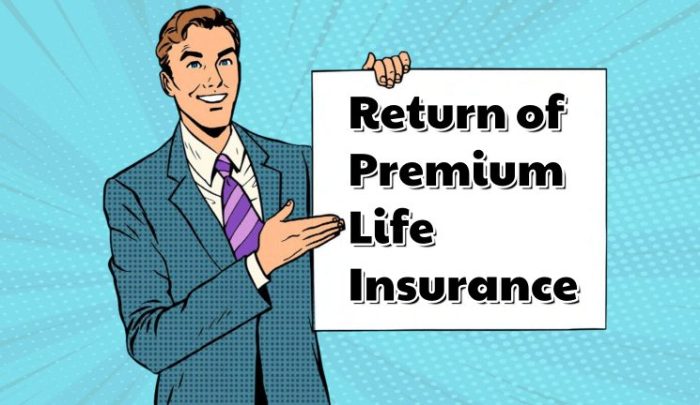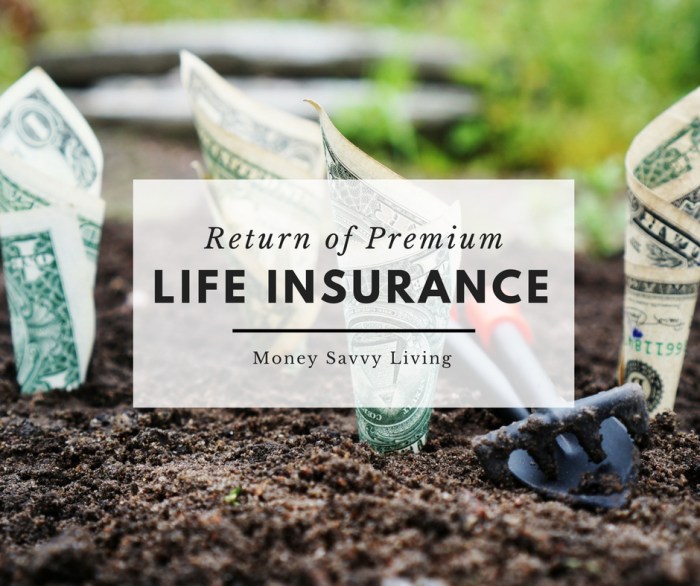Return of premium (ROP) life insurance offers a unique proposition: the potential to recoup all or a significant portion of your premiums paid if you outlive the policy term. This innovative approach blends traditional life insurance protection with a savings element, appealing to those seeking both security and a potential financial return. This guide delves into the intricacies of ROP policies, examining their financial aspects, benefits, and comparison to other insurance options to help you make an informed decision.
We will explore the various types of ROP policies available, analyze their cost-effectiveness against traditional term life insurance, and clarify the tax implications of premium refunds. Furthermore, we will consider scenarios where an ROP policy might be particularly advantageous and contrast it with alternatives like whole life insurance. By the end, you will possess a clearer understanding of whether a return on premium life insurance policy aligns with your individual financial goals.
Defining Return on Premium Life Insurance

Return of premium (ROP) life insurance is a type of life insurance policy that guarantees the return of all or a portion of the premiums paid, provided certain conditions are met. This differs from traditional life insurance, where the premiums are essentially a cost for the death benefit and are not returned. ROP policies offer a unique blend of life insurance coverage and a savings component, appealing to those seeking both protection and a potential financial return.
Return of premium policies function by accumulating a cash value component alongside the death benefit. This cash value grows over time, often tax-deferred, and is designed to eventually equal or exceed the total premiums paid. Upon the policyholder’s death, the beneficiary receives the death benefit. If the policyholder survives the policy term, the accumulated cash value, representing the returned premiums, is paid out. The specific terms and conditions for premium return vary significantly between policies and insurers.
Types of Return of Premium Policies
There isn’t a rigid categorization of ROP policies, but they generally fall under the umbrella of whole life, term life, or universal life insurance structures. The key differentiator is the inclusion of the return of premium rider or feature. The specific mechanics of the return will vary based on the underlying policy type. For example, a whole life ROP policy will build cash value more slowly than a term life ROP policy with a shorter term, influencing the overall return.
Examples of Return of Premium Features
A common example involves a 20-year term life insurance policy with a return of premium rider. If the policyholder dies within the 20-year term, the beneficiary receives the death benefit. However, if the policyholder survives the 20-year term, the insurer returns all premiums paid, effectively making the life insurance “free” in terms of net cost to the policyholder. Another example could involve a universal life policy with an ROP feature. In this scenario, the cash value component grows at a rate influenced by the policy’s performance and credited interest rates. If this cash value reaches the total premium paid before the policyholder’s death, the excess will be paid out as a return of premium upon the policy’s maturity or the policyholder’s death. The specific terms, such as the timing of the premium return and any conditions attached, would be detailed within the policy contract. It’s crucial to carefully review the policy documents to understand the exact terms and conditions governing the return of premium.
Financial Aspects of Return on Premium Life Insurance

Return of premium (ROP) life insurance offers a unique financial proposition, promising a full refund of premiums paid if the policyholder survives the policy term. Understanding the financial implications, however, requires a careful comparison with traditional options and a clear grasp of the tax treatment. This section delves into the key financial aspects to help you make an informed decision.
Cost Comparison with Traditional Term Life Insurance
ROP policies generally cost significantly more than traditional term life insurance policies providing the same death benefit. This increased cost reflects the built-in return of premiums feature. A traditional term policy offers a lower premium for a set period, but provides no refund if the insured survives the term. The choice depends on individual priorities: prioritizing affordability versus the guarantee of premium return. For example, a 30-year-old male seeking $500,000 in coverage might find a 20-year term policy costs significantly less annually than a comparable ROP policy, but the ROP policy would return all premiums after 20 years if he’s still alive.
Tax Implications of Premium Refunds
The tax implications of receiving a premium refund from an ROP policy are generally favorable. The premiums paid are not tax-deductible, as with most life insurance policies. However, the returned premiums are typically considered a tax-free return of capital. This means you won’t owe any income tax on the refunded amount. This contrasts with other investments where returns may be subject to capital gains taxes. It’s always advisable, however, to consult with a qualified tax advisor to ensure accurate understanding based on your specific circumstances and jurisdiction.
Hypothetical Premium Payment and Return Comparison
The following table illustrates a hypothetical comparison of premium payments and potential returns for a $500,000 ROP policy versus a traditional term policy over different timeframes. Remember, these are illustrative examples and actual costs will vary based on individual factors like age, health, and insurer.
| Policy Type | Policy Term (Years) | Annual Premium | Total Premiums Paid | Potential Return (End of Term) |
|---|---|---|---|---|
| ROP | 20 | $2,500 | $50,000 | $50,000 |
| Term | 20 | $1,500 | $30,000 | $0 |
| ROP | 30 | $2,000 | $60,000 | $60,000 |
| Term | 30 | $1,000 | $30,000 | $0 |
Understanding Policy Benefits and Riders
Return of premium (ROP) life insurance policies offer a unique blend of life insurance coverage and a potential return of premiums paid. Understanding the advantages and disadvantages, along with the associated riders, is crucial for determining if this type of policy aligns with your financial goals.
ROP policies provide a death benefit to your beneficiaries in the event of your passing, much like traditional life insurance. However, the key differentiator is the promise to return all or a significant portion of the premiums paid over the policy term if you survive. This feature adds a savings component to the traditional life insurance protection.
Advantages and Disadvantages of Return of Premium Policies
Choosing a return of premium policy presents several potential benefits, but it’s also important to weigh the drawbacks. The decision hinges on individual circumstances and financial priorities.
- Advantage: Premium Refund: The primary advantage is the potential return of premiums paid. This acts as a form of guaranteed savings, providing a financial cushion if you outlive the policy term.
- Advantage: Life Insurance Coverage: Simultaneously, you secure life insurance protection for your loved ones during the policy’s duration.
- Disadvantage: Higher Premiums: ROP policies typically come with higher premiums compared to traditional term or whole life insurance policies offering similar death benefit coverage. This is because of the added savings component.
- Disadvantage: Potential Lower Returns: While premiums are returned, the total return may be less than what could have been achieved through alternative investment strategies, especially if market performance is strong.
Common Riders in Return of Premium Life Insurance
Many ROP policies offer the option to add riders, which enhance the policy’s coverage and benefits. These riders typically come with an additional cost.
- Accidental Death Benefit Rider: This rider increases the death benefit if the insured dies due to an accident. For example, a policy with a $500,000 death benefit might pay out $1 million if death results from an accident.
- Waiver of Premium Rider: This rider waives future premiums if the insured becomes totally disabled. This ensures the policy remains in force even if the insured can no longer afford the premiums.
- Critical Illness Rider: This rider provides a lump-sum payment if the insured is diagnosed with a critical illness such as cancer, heart attack, or stroke. This payment can be used to cover medical expenses or other related costs.
- Long-Term Care Rider: This rider provides benefits to help cover the costs of long-term care, such as nursing home or assisted living expenses. This can help protect your assets and provide financial support during a period of significant healthcare needs.
Scenarios Where a Return of Premium Policy Might Be Beneficial
A return of premium policy can be a suitable choice in specific situations.
- Individuals with a High Risk Tolerance: While premiums are higher, the guaranteed return of premiums can offer peace of mind for those who prefer a less volatile investment strategy.
- Individuals Prioritizing Savings and Insurance: For individuals who want both life insurance protection and a savings element, ROP policies offer a combined approach. This eliminates the need to manage separate savings and insurance accounts.
- Estate Planning: The return of premiums can supplement estate assets, providing a financial boost for beneficiaries if the insured survives the policy term. For example, a policy with a $1 million death benefit and premium return of $500,000 could significantly benefit the estate.
Comparing Return on Premium with Other Life Insurance Options

Choosing the right life insurance policy depends heavily on individual needs and financial goals. Understanding the nuances of different policy types is crucial for making an informed decision. This section compares Return of Premium (ROP) life insurance with two common alternatives: whole life insurance and term life insurance. This comparison highlights the key differences in cost, coverage, and long-term value.
Return of Premium vs. Whole Life Insurance
ROP and whole life insurance represent distinct approaches to life insurance. Whole life insurance offers lifelong coverage, building cash value that grows tax-deferred over time. This cash value can be borrowed against or withdrawn, offering a financial safety net. Conversely, ROP policies provide a death benefit and guarantee the return of all premiums paid, typically after a specific period or upon the policyholder’s death, if the death occurs before the return of premium period ends. The key difference lies in the cash value accumulation; whole life policies build substantial cash value, while ROP policies prioritize premium return. The choice between them hinges on whether the policyholder prioritizes lifelong coverage with cash value growth or the guaranteed return of premiums. A person with a shorter-term financial goal might find the ROP option more attractive, whereas someone seeking long-term financial security and potential cash value growth might opt for whole life.
Return of Premium vs. Term Life Insurance
Term life insurance provides coverage for a specified period (term), offering a lower premium compared to permanent policies like ROP or whole life. This makes it an affordable option for individuals needing coverage for a specific timeframe, such as mortgage repayment or raising children. ROP policies, while also offering a defined period of premium return, are generally more expensive than term life insurance due to the guaranteed return of premiums. The decision between these two depends on the length of coverage needed and the willingness to pay a higher premium for the premium return guarantee. If the need for life insurance is temporary, term life insurance offers a cost-effective solution. If the need for life insurance and the return of premium are both important considerations, ROP is the more suitable choice.
Key Differences Between ROP, Whole Life, and Term Life Insurance
The following points summarize the key distinctions between these three policy types:
- Coverage Period: Term life insurance covers a specific period; whole life insurance provides lifelong coverage; ROP insurance provides coverage for a specific period, with a return of premiums.
- Premium Costs: Term life insurance typically has the lowest premiums; ROP insurance premiums are higher than term but lower than whole life; whole life insurance has the highest premiums.
- Cash Value: Term life insurance has no cash value; whole life insurance builds cash value; ROP insurance may offer limited or no cash value.
- Premium Return: Term life insurance does not return premiums; whole life insurance does not return premiums; ROP insurance guarantees the return of all premiums paid (under specific conditions).
- Death Benefit: All three offer a death benefit, but the amount and payout conditions vary based on policy terms.
Illustrative Scenarios and Examples
Return of premium (ROP) life insurance policies offer a unique blend of life insurance coverage and a potential financial return. Understanding how this feature plays out in different life situations is crucial to assessing its value. The following scenarios illustrate the benefits and potential drawbacks of ROP policies.
ROP Benefits for a Family with Young Children
A young couple, Sarah and John, with two young children, purchase a 20-year ROP term life insurance policy. The policy provides a substantial death benefit, ensuring financial security for their children should either parent pass away. The premiums are higher than a standard term life policy, but the knowledge that they will receive a full return of premiums at the end of the 20-year term provides significant peace of mind. Should both parents survive the term, they receive a substantial lump sum, which can be used for their children’s college education, retirement planning, or other significant life goals. This demonstrates how ROP can offer both protection and a potential financial windfall, effectively hedging against the risk of premature death while also providing a financial benefit if they live to the end of the policy term.
Detailed Example of a Valuable ROP Feature
Consider a 40-year-old professional, David, who purchases a 20-year ROP policy with a $500,000 death benefit. His annual premium is $3,000. Over 20 years, he pays a total of $60,000 in premiums. If David passes away within the 20-year term, his beneficiaries receive the $500,000 death benefit. If David survives the 20-year term, he receives the full $60,000 in premiums back, essentially making the life insurance coverage “free” from a financial perspective. This outcome underscores the value proposition of ROP policies: protection and a guaranteed return of investment if the insured lives to the end of the policy term. The policy acts as a form of savings plan with an added death benefit, offering a unique financial advantage.
Scenario Where ROP Might Not Be Cost-Effective
An individual prioritizing the lowest possible premiums might find a standard term life insurance policy more cost-effective than an ROP policy. For instance, a healthy 30-year-old seeking only basic life insurance coverage might find that a standard term policy offers significantly lower premiums, even if it doesn’t offer a return of premiums. The trade-off is the absence of the potential return of premiums at the end of the policy term. This individual might prefer to invest the premium difference elsewhere, potentially achieving a higher return. In this scenario, the cost of the ROP’s guaranteed return outweighs the benefit for the individual’s specific financial goals. This highlights that ROP policies aren’t always the optimal choice and should be carefully considered in light of individual financial circumstances and risk tolerance.
Final Review
Return on premium life insurance presents a compelling alternative to traditional life insurance, offering the dual benefit of protection and potential premium recovery. While the cost may be higher than standard term life insurance, the possibility of a full premium refund provides a significant financial incentive for certain individuals. Ultimately, the decision of whether or not to purchase an ROP policy hinges on a careful assessment of your individual risk tolerance, financial objectives, and long-term planning. Thoroughly researching your options and consulting with a qualified financial advisor is crucial to ensure a well-informed choice that aligns with your specific circumstances.
FAQ Insights
What happens if I die during the policy term of a Return of Premium life insurance policy?
Your beneficiaries will receive the death benefit, as with any life insurance policy. The return of premium feature is only activated if you survive the entire policy term.
Are there any health requirements to qualify for a Return of Premium policy?
Yes, insurers will assess your health status to determine eligibility and premiums. Pre-existing conditions may impact your ability to obtain coverage or result in higher premiums.
Can I withdraw the accumulated premiums before the policy term ends?
Generally, no. The return of premium is typically paid out only at the end of the policy term if you are still alive. Early withdrawals are usually not permitted.
How does inflation affect the value of the returned premium?
The returned premium will be the same amount as the premiums paid, but its purchasing power may be reduced by inflation over the policy term. This is a factor to consider when evaluating the long-term value.